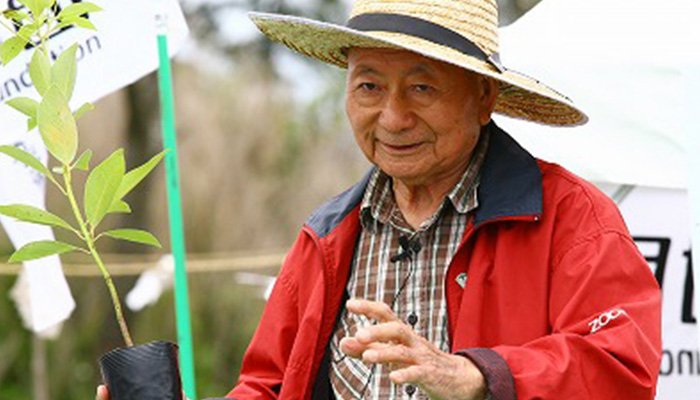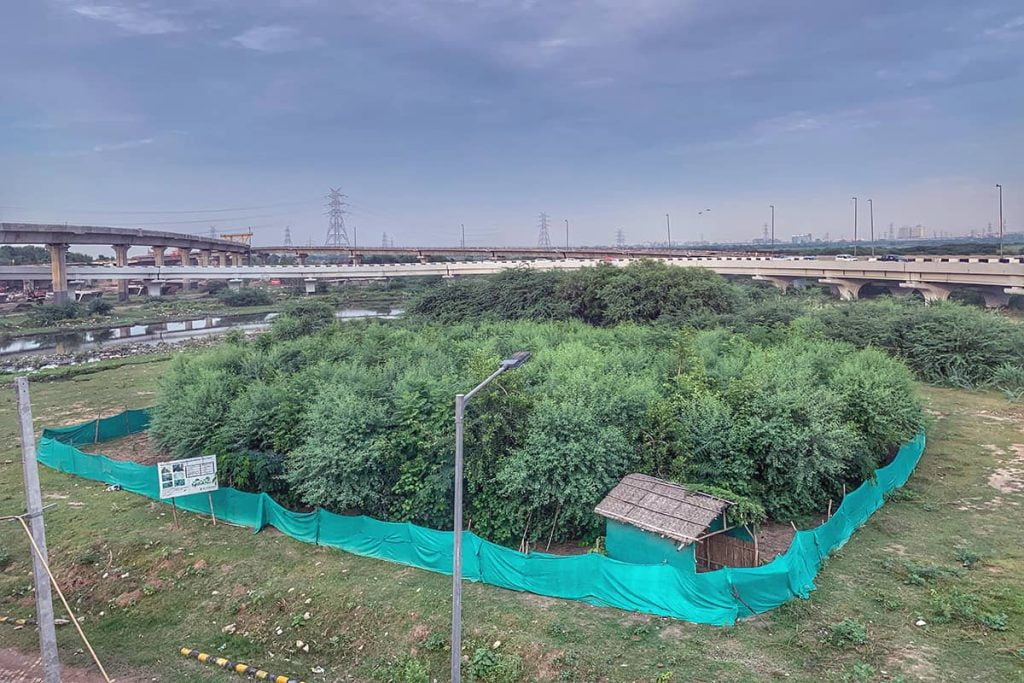The ‘Miyawaki method’ refers to an afforestation method developed by Japanese scientist Dr. Akira Miyawaki. The forests developed using this method are fast growing, have dense vegetation and overtime require little to no management. The Miyawaki method and its strategies are extremely effective in developing forests on small landholdings (as small as 10-20 cents). It is also a useful tool in Urban Forestry projects and developing recreational parks.

Miyawaki Method as a Restoration Tool
If left undisturbed and devoid of human influence, land begins to house plant communities (sometimes as sparse as in the deserts, sometimes as dense as the rainforests). This natural potential of the land to generate vegetation has been severely impacted by human activities that has damaged soil structure, depleted nutrients, caused the accumulation of toxic substances and harmed beneficial biodiversity. The Miyawaki method provides a useful blueprint towards restoring native forests (more than half of all plants selected for a Miyawaki forest being native plants). Mindful management in the initial years of planting and developing the forest results in ensuring the majority of the saplings planted survive and the forest ecosystem is established in decades (a fraction of the time taken for forests to develop naturally).
Before we delve into the Miyawaki method and its strategies it is important to observe how natural forests function. Forests are not just comprised of trees. It contains plants of varied sizes, fungi, wildlife and microorganisms. This community of flora and fauna play an important role in maintaining the forest and allowing it to thrive. Birds introduce seeds into the forest, animal dung nourishes the land, leaf litter fallen from the trees are broken down by decomposers to make healthy soil and the roots of plants hold the soil in place. But the process through which forests grow, generates multiple canopy layers and become self-sustainable is a time taking process. The Miyawaki method accelerates the rate at which forests develop by building soil, utilizing native plant diversity, growing healthy saplings and planting them close to one another (at distances of 50-80 centimeters).
Designing and Developing a Miyawaki Forest: How to Grow a Miyawaki Forest
Step 1: Procure saplings of native tree and shrub varieties.
Saplings of native plants are generally cheaper than exotic and ornamental plants (with prices usually ranging from 10-80 Rs). However, procuring plants for larger plots may be expensive as an average of 4000 trees or more are planted per acre in the Miyawaki method. Developing a nursery and propagating the plants can effectively bring down the cost. Growing plants in pots or grow bags allows for more effective management of the growing medium; making it easier to manage the soil in which the sapling grows. This ensures the soil is healthy and nutrient rich. Plants are also easier to water and nurse in case of disease when grown in pots. Healthy saplings can then be transplanted onto the demarcated forest patch sometime between a few months to a year.
Step 2: Once the plants are ready to be transplanted, soil preparation processes begin.
First holes of one meter depth are dug. The soil dug out is checked, understanding the soil of the forest patch helps a grower intervene more effectively to enhance its quality. Growers employ a range of strategies like adding compost, cocopeat, groundnut shells, beneficial micro-organisms and shredded leaf litter to enhance the soil. Once the soil is treated, the saplings are placed into the holes and the soil is returned to where it was dug out from.
Step 3: The trees planted need to be watered regularly henceforth.
Having an irrigation line or water outlet that allows you to reach all trees is essential. The trees need to be watered everyday (or as frequently to ensure that the soil surface does not dry out). Watering requirements reduce sharply after the first year or two.
Step 4: Insert support sticks for the saplings
Hard wooden sticks are firmly inserted next to the saplings. The saplings are then tied and secured to the stick. This provides support for the sapling. This ensures the saplings grow straight and doesn’t droop. The additional support also provides a degree of protection during bad weather.

Step 5: Mulch is introduced into the forest patch
The soil is covered with organic matter, growers usually spread-out hay or leaf litter so as to create a blanket layer to protect the soil. Mulching protects the soil from direct sunlight, reduces the rate at which soil moisture is lost, catalyzes the growth of beneficial biodiversity (everything from earthworms to microorganisms that break down nutrients for plants to absorb) and leaf litter itself breaks down slowly improve soil health.
Step 6: Monitor the growth of the Miyawaki Forest
Pay regular visits to the forest patch and examine the saplings. This way a grower can ensure his watering method is working, identify and remove weeds, detect any infection in a sapling and treat it. This step exponentially increases the chances all saplings survive and the forest establishes itself quickly.
Growing a Miyawaki Forest in Kerala
Numerous Miyawaki forests have successfully been established in Kerala and in other parts of India. There is also a rise in the popularity of the Miyawaki method in Kerala with the state tourism department announcing a ‘Miyawaki Forest project’ in 2020 with the objective of developing 22 forests using the Miyawaki Method and with the emergence of grassroot collectives that promote education regarding the Miyawaki method. Indian businesses offering services to grow compact forests on private landholdings using Miyawaki techniques have also entered the market.
Kerala has a rich diversity of native plants, numerous of which serve as food and medicine. This diversity allows a grower to pick from a wide array of plants that can serve to increase the ability of the forest to provide for the grower (specifically as food and raw material for therapeutic uses). Further the abundance sunlight and rainfall throughout most of the year allow Miyawaki Forests to establish themselves, grow tall and dense rapidly. Creating such native forests serve to protect native plant diversity, local wildlife and provide protection from environmental degradation (preventing erosion and improving the water table). The Miyawaki method has provided a useful blueprint for agencies and stakeholders involved in afforestation to increase green cover, restore native forests, mitigate climate change and environmental disasters.
Cost v/s Benefits of Miyawaki forest in India
Miyawaki forests usually require an initial investment, this may include setting up a watering system, labor during planting and through the first few years of growth, the cost of saplings and the cost of soil additives. Several successful Miyawaki farms in Kerala have been established at the cost of 10- 20 lakh rupees (which is a rather expensive investment for most Indians). The forests also provide lower financial returns compared to monocropping silviculture (growing rubber, teak etc.). However, unlike commercial silviculture the input costs for a Miyawaki forest reduces with each successive year. This means in the long run after the initial period of growth, investment requirements and little to none. Generating small clusters (under 50 cents of land) in Homesteads and Gardens using this method can be very affordable especially if it already possesses water outlets and accesses to gardening tools. Growers have also resorted to numerous strategies to derive economic value from Miyawaki Forest patches by addition of high value native timber trees, developing ‘Miyawaki Fruit Forests’, providing tours and education sessions of their forests and growing practices. Miyawaki forests also bring value to the grower in numerous other ways such as protecting the soil from erosion and managing overall soil health, improving the water table and access to water. It allows the grower to contribute positively to larger climate change related problems by adding green cover and building a microhabitat for local biodiversity. It also provides opportunities for nature walks and forest bathing (eco-therapy).
Importance of Miyawaki forests
A method to grow dense forest vegetation in a short period of time is extremely useful in combating present day environmental problems. Protecting biodiversity and native plants, reducing extinction rates by creating habitats, improving overall environmental quality by increasing forest cover and using trees as a buffer against environmental disasters are all considered integral to protecting life on the plant and rectifying human-caused damage. The Miyawaki method is a possible candidate for achieving goals to make the world more habitable and to protect ecologically fragile regions. Small high-density forests could potentially open up a ‘new possibility’ of co-existence, where human settlements coexist with forest habitats. Developing small clusters of forests across Urban areas and Homesteads would cumulate into a massive area under forest cover and provide sanctuary from non-human animals in the otherwise inhospitable towns and cities. Miyawaki Forests can be deployed in ecologically unsound areas to reduce erosion and break the force of wind and water. The method can be useful in restoring groves lost to deforestation, groves play a significant role in regulating environmental health and supporting local biodiversity.

The Miyawaki method or Potted Seedling method is easy to learn and implement. It is easy for any environmentally conscious individual or amateur grower to understand and develop their own forests. The ability of this method to succeed even in small spaces (less than 20 cents) opens it up to a wider audience. Understanding the Miyawaki method can benefit a diverse group of individuals ranging from gardening enthusiasts, conservation forestry professionals, citizen environmentalists and just about anyone motivated to grow a forest.
SpiceTree’s Green Initiative
The Miyawaki Method has helped SpiceTree to successfully execute its afforestation efforts. SpiceTree has planted 45,000 trees using the Miyawaki method and intends to plant a total of one lakh trees in this decade.



